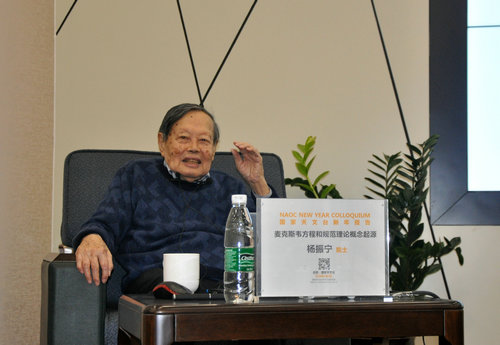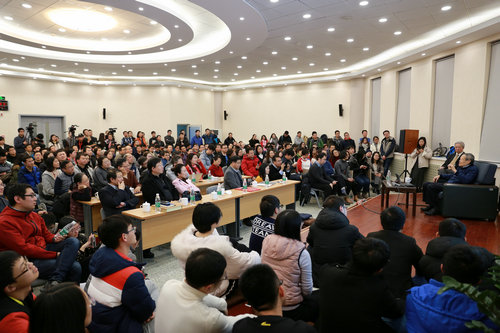
"The electromagnetic phenomenon is an incredible miracle of our universe, and to reveal mysteries behind it will need the efforts of younger generations of scientists,” said Chen-Ning Yang, who shared the 1957 Nobel Prize in Physics for the discovery of parity non-conservation of weak interaction.
In his new year talk “Conceptual Origins of Maxwell Equations and of Gauge Theory of Interactions” given at the National Astronomical Observatories, Chinese Academy of Sciences (NAOC) in Beijing on January 3, Yang revisited the century-long history from the birth of electromagnetism to the early development of particle physics, including his work on the Yang-Mills Theory which is considered the most significant part of his scientific career.
The Yang-Mills Theory proposed by Yang and Mills in 1954 is a fundamental contribution to modern physics. By extending Maxwell’s unified theory of electromagnetism to describe the behavior of nuclear particles, the Yang-Mills Theory explains how three of the four basic interactions in the universe (the electromagnetic, weak and strong forces) work. Their theory forms the basis of our understanding of the Standard Model. It was selected as one of the seven Millennium math problems by the Clay Mathematics Institute of Cambridge in 2000, and was eventually confirmed with the detection of the Higgs boson at LHC in 2012.
The talk attracted a crowd of nearly 300 people to tightly pack NAOC’s auditorium, as well as more than 60,000 to watch online.
After his talk, Yang took questions from the audience. He used his own childhood and college experiences to emphasize the importance of identifying and pursuing personal interest. The key to success is to “follow your interest and ability,” he told young researchers. He also offered suggestions to middle school students on how to better learn physics.
The world-renowned physicist also envisioned the future of physics research. The unification of the Standard Model and General Relativity has been the biggest challenge over the past forty years, he said, and “since it has so many physical and mathematical complications, I don’t see any quick solution coming within the next decade or two.” And even the puzzle is solved one day, it is still not the end of the story. “We need to answer ultimate questions like ‘why are we able to understand the universe?’”, Yang said.
Born in Hefei in 1922 to a mathematician and a housewife, Yang showed huge interest and talent in math and physics as a kid. He attended the National Southwestern Associated University in Kunming for seven years during the Sino-Japanese War, before moving to the US to pursue his PhD at the University of Chicago. After that he worked at the University of Chicago, Princeton, and Stony Brook until his retirement in 1999. Yang has received numerous awards for his pioneering work on statistical mechanics and particle physics, including the Nobel Prize in Physics (1957), the National Medal of Science (1986), the Benjamin Franklin Medal (1993) and the Albert Einstein Medal (1995). He moved back to China a few years ago. At the age of 95, he is now honorary director and professor at the Institute for Advanced Study, Tsinghua University in Beijing.
Yang has been a strong supporter of Chinese astronomy. He serves as chairman of the board of adjudicators for the famous Shaw Prize, known as “the Nobel Prize of the East” which awards outstanding individuals in the fields of astronomy, mathematics and life sciences. Last October, he visited the Five-hundred-meter Aperture Spherical radio Telescope built and run by NAOC in Guizhou.

The New Year Talk by Prof Chen-Ning Yang

The Enthusiastic Audience at NAOC

86-10-68597521 (day)
86-10-68597289 (night)

52 Sanlihe Rd., Xicheng District,
Beijing, China (100864)

